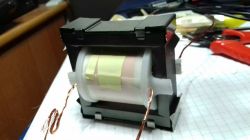I'm going to make a really extensive article about this construction, but that's how I can describe it for a short time.
Once I bought the book "Resonance circuits in power electronics" Tadeusz Citko, Henryk Tunia, Bolesław Winiarski. A very theoretical book, but that was what I needed - simplified mathematical models.
There is a description of the construction "Serial inverters with a receiver connected in parallel to the capacitor", which construction in the world is called LCC and is a current source.
Powered from 30V, but as it is a half bridge, 15V goes to the resonance circuit itself, the transformer ratio is 14: 850, which does not give much voltage with such a transmission. Due to the fact that the system works in resonance, reactive energy accumulates in the capacitor, which causes a voltage increase on this capacitor, and I decided that the capacitor will be ... the secondary winding. This works very well, although it will not be a cosmic efficiency construction, but you can get rid of the capacity problem on the secondary side to some extent.
In a simple model it works like this:
http://tinyurl.com/wq2s7d2






